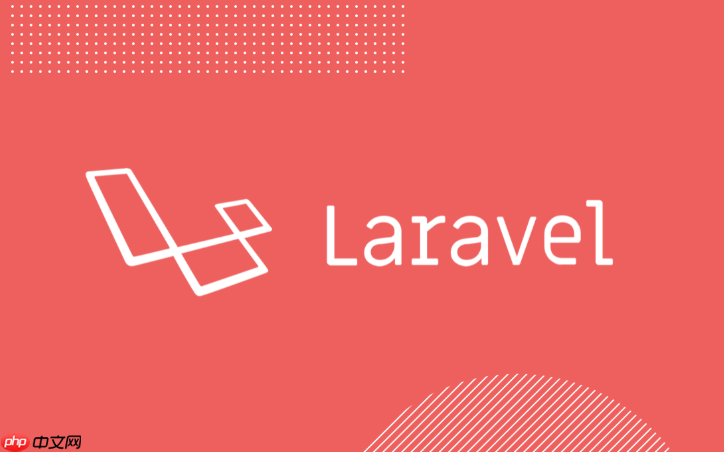Laravel支持通过闭包和规则类创建自定义验证规则,闭包适用于简单、一次性逻辑,而规则类更利于复用和维护;当业务逻辑复杂、需外部数据依赖或跨多处使用时,应优先使用可注入服务、支持本地化消息的规则类。

Laravel提供了一套非常灵活的机制来让你定义自己的数据验证逻辑。简单来说,当你内置的验证规则无法满足你的业务需求时,你可以通过两种主要方式来创建自定义规则:一种是快速便捷的闭包(Closure)形式,另一种是更结构化、可复用的验证规则类(Rule Class)。这两种方式各有侧重,但核心都是让你能更精确地控制数据的合法性。
解决方案
在Laravel中,创建自定义验证规则主要有以下几种实践方式,我个人在不同的场景下会选择不同的方法。
1. 使用闭包(Closure)定义内联规则
这是最直接、最快速的方式,特别适合那些只在特定地方使用一次的简单验证逻辑。你可以在Validator::make方法或者FormRequest的rules()方法中直接嵌入一个闭包。
use IlluminateSupportFacadesValidator; use Closure; // 假设我们有一个请求数据 $data = [ 'promo_code' => 'INVALID123', ]; $validator = Validator::make($data, [ 'promo_code' => [ 'required', 'string', function (string $attribute, mixed $value, Closure $fail) { // 这里可以写你的自定义逻辑 // 比如检查数据库中是否存在这个优惠码,或者它是否有效 if ($value === 'INVALID123') { $fail("提供的 :attribute 无效,请检查。"); } // 甚至可以调用外部服务进行验证 // if (! SomeApiService::isValidPromoCode($value)) { // $fail("优惠码 {$value} 不存在或已过期。"); // } }, ], ]); if ($validator->fails()) { // 处理验证失败 // dd($validator->errors()); }
在FormRequest中也是类似的:
// app/Http/Requests/StoreOrderRequest.php namespace AppHttpRequests; use IlluminateFoundationHttpFormRequest; use Closure; class StoreOrderRequest extends FormRequest { public function rules(): array { return [ 'product_id' => ['required', 'exists:products,id'], 'quantity' => ['required', 'integer', 'min:1'], 'delivery_date' => [ 'required', 'date', function (string $attribute, mixed $value, Closure $fail) { // 确保配送日期不是周末 if (date('N', strtotime($value)) >= 6) { // 6 = Saturday, 7 = Sunday $fail("配送日期不能是周末。"); } // 确保配送日期在未来 if (strtotime($value) < time()) { $fail("配送日期不能是过去的时间。"); } }, ], ]; } }
这种方式简单直接,但如果你的验证逻辑需要在多个地方复用,或者逻辑本身比较复杂,那闭包就会让代码显得臃肿,维护起来也比较麻烦。
2. 创建独立的验证规则类(Rule Class)
对于那些需要复用、逻辑更复杂或者需要依赖注入的验证规则,我强烈推荐使用独立的验证规则类。Laravel提供了一个Artisan命令来帮你快速生成:
php artisan make:rule MyCustomRule
这会在app/Rules目录下创建一个新的文件,例如app/Rules/MyCustomRule.php。
// app/Rules/MyCustomRule.php namespace AppRules; use Closure; use IlluminateContractsValidationValidationRule; // 如果你的规则需要访问容器,可以实现 ImplicitRule 或 DataAwareRule 接口 // use IlluminateContractsValidationImplicitRule; // use IlluminateContractsValidationDataAwareRule; class MyCustomRule implements ValidationRule { protected $minAllowedValue; public function __construct(int $minAllowedValue = 0) { $this->minAllowedValue = $minAllowedValue; } /** * Run the validation rule. * * @param Closure(string): IlluminateTranslationPotentiallyTranslatedString $fail */ public function validate(string $attribute, mixed $value, Closure $fail): void { // 这里的 $attribute 是字段名, $value 是字段值 // 假设我们想验证一个值是否是偶数,并且大于某个最小值 if (!is_numeric($value) || $value % 2 !== 0) { $fail("The :attribute must be an even number."); return; // 验证失败后通常会直接返回 } if ($value < $this->minAllowedValue) { $fail("The :attribute must be at least {$this->minAllowedValue}."); } // 如果需要访问请求中的其他数据,可以在构造函数中注入或者实现 DataAwareRule 接口 // 比如,如果需要检查另一个字段的值: // if ($this->data['another_field'] === 'some_value' && $value === 'other_value') { // $fail("根据另一个字段的条件,:attribute 的值不符合要求。"); // } } }
在validate方法中,你需要编写核心的验证逻辑。如果验证失败,就调用$fail()闭包并传入错误消息。这个$fail闭包会帮你处理错误消息的本地化和占位符替换。
使用这个自定义规则也很简单,直接实例化它并传入验证器:
use AppRulesMyCustomRule; $data = [ 'amount' => 10, ]; $validator = Validator::make($data, [ 'amount' => ['required', 'integer', new MyCustomRule(5)], // 传入构造函数参数 ]); if ($validator->fails()) { // dd($validator->errors()); // amount: The amount must be at least 5. } $data = [ 'amount' => 7, // 奇数 ]; $validator = Validator::make($data, [ 'amount' => ['required', 'integer', new MyCustomRule(5)], ]); if ($validator->fails()) { // dd($validator->errors()); // amount: The amount must be an even number. }
这种方式让验证逻辑更清晰、更易于测试和维护。
为什么需要自定义Laravel验证规则?何时使用自定义验证逻辑?
说实话,Laravel内置的验证规则已经非常强大了,覆盖了我们日常开发中绝大多数场景。但总有那么些时候,你的业务逻辑会跳出框架预设的条条框框。这时候,自定义规则就显得尤为重要。
我个人觉得,你需要自定义验证规则,通常是出于以下几个原因和场景:
- 复杂的业务逻辑判断: 比如,一个用户的年龄必须在18到60岁之间,并且TA的账户类型必须是“高级会员”才能进行某个操作。或者,一个商品的价格必须是特定供应商允许的范围,并且库存必须大于零且小于最大承载量。这些组合条件,内置规则很难直接表达。
- 外部数据依赖: 你的验证可能需要查询数据库(比如验证某个优惠码是否存在且未被使用)、调用外部API(比如验证一个地址是否真实有效,或者一个身份证号码是否合法),甚至是读取文件。内置规则无法直接触及这些外部资源。
- 可重用性和代码整洁: 如果某个验证逻辑会在应用的多个地方出现,将其封装成一个独立的规则类,可以避免代码重复,提高代码的可读性和可维护性。想象一下,如果每次都写一个闭包来验证“密码必须包含大小写字母、数字和特殊字符”,那会是多大的灾难。
- 动态条件验证: 有时候,一个字段的验证规则可能依赖于请求中的其他字段。比如,如果
payment_method是FormRequest0,那么FormRequest1和FormRequest2就是必填的。虽然Laravel有FormRequest3这类规则,但更复杂的联动验证,自定义规则能提供更精细的控制。 - 特定格式或语义验证: 比如,验证一个自定义的订单号格式(
FormRequest4),或者一个产品SKU是否符合内部编码规范。这些都是内置规则无法理解的“语义”。
何时使用?我的经验是,当你发现:
- 内置规则组合起来变得异常复杂,甚至需要嵌套多个
FormRequest5、FormRequest3等,让规则数组变得难以阅读时。 - 你需要执行数据库查询、API请求或者其他I/O操作来判断数据的合法性时。
- 同一个验证逻辑将会在至少两个不同的地方被用到时。
这时候,就果断考虑自定义规则吧。它能让你的验证逻辑更清晰,代码更专业。
如何创建可复用的自定义验证规则类?
创建可复用的自定义验证规则类,核心在于其结构和如何利用Laravel的IoC容器。我前面已经提到了FormRequest7这个命令,它会生成一个基础的规则类。但要让它真正“可复用”,还有一些细节可以深挖。
1. 构造函数注入依赖:
这是让规则类可复用的一个关键点。如果你的验证逻辑需要依赖其他服务、仓库(Repository)或者配置项,你可以通过构造函数将它们注入进来。Laravel的IoC容器会自动解析这些依赖。
// app/Rules/UniqueEmailAcrossMultipleTables.php namespace AppRules; use Closure; use IlluminateContractsValidationValidationRule; use AppServicesUserService; // 假设有一个用户服务 class UniqueEmailAcrossMultipleTables implements ValidationRule { protected UserService $userService; protected ?int $ignoreUserId; // 允许在更新时忽略当前用户 public function __construct(UserService $userService, ?int $ignoreUserId = null) { $this->userService = $userService; $this->ignoreUserId = $ignoreUserId; } public function validate(string $attribute, mixed $value, Closure $fail): void { // 假设我们要在 users 和 vendors 表中检查邮箱唯一性 if ($this->userService->emailExistsInUsersAndVendors($value, $this->ignoreUserId)) { $fail("The :attribute is already taken."); } } }
使用时:
use AppRulesUniqueEmailAcrossMultipleTables; use AppServicesUserService; // 确保服务可以被解析 // 在控制器或FormRequest中 public function rules(): array { $userId = $this->route('user') ? $this->route('user')->id : null; // 更新场景 return [ 'email' => [ 'required', 'email', // Laravel会自动解析 UserService 实例并注入 new UniqueEmailAcrossMultipleTables(app(UserService::class), $userId), ], ]; }
通过构造函数注入,你的规则类就拥有了执行复杂逻辑的能力,并且其依赖是可控的,这对于单元测试也很有帮助。
2. 灵活的错误消息:
在validate方法中,你通过$fail()闭包来设置错误消息。这个闭包接受一个字符串,你可以直接写死消息,也可以利用Laravel的本地化功能。
3. rules()0和rules()1 (进阶):
-
rules()0: 如果你的规则是一个“隐式”规则,即当字段不存在时,它不应该失败,只有当字段存在且不符合规则时才失败。例如,rules()3字段的规则。实现rules()4接口。 -
rules()1: 如果你的规则需要访问验证器中的所有数据(不仅仅是被验证的当前字段值),你可以实现rules()6接口,然后实现rules()7方法。这在你需要基于其他字段的值来验证当前字段时非常有用。
// app/Rules/ConditionalFieldRequired.php namespace AppRules; use Closure; use IlluminateContractsValidationDataAwareRule; use IlluminateContractsValidationValidationRule; class ConditionalFieldRequired implements ValidationRule, DataAwareRule { protected array $data = []; public function setData(array $data): static { $this->data = $data; return $this; } public function validate(string $attribute, mixed $value, Closure $fail): void { // 如果 payment_method 是 'bank_transfer',那么 account_number 必须存在 if (isset($this->data['payment_method']) && $this->data['payment_method'] === 'bank_transfer') { if (empty($value)) { $fail("When payment method is bank transfer, the :attribute is required."); } } } }
使用时:
use AppRulesConditionalFieldRequired; $data = [ 'payment_method' => 'bank_transfer', // 'account_number' => '123456789', // 缺少此字段会导致验证失败 ]; $validator = Validator::make($data, [ 'payment_method' => ['required', 'string'], 'account_number' => [new ConditionalFieldRequired()], ]);
这样,你的规则类就不仅仅是简单的值检查,它能感知整个请求上下文,变得更加智能和强大。
自定义验证规则的错误消息如何本地化和定制化?
错误消息的本地化和定制化,是提升用户体验非常关键的一环。毕竟,没人喜欢看到硬编码的英文错误提示。Laravel在这方面提供了非常友好的支持。
1. 在规则类中直接定义消息:
最直接的方式就是在validate方法中,通过$fail()闭包传入你想要的错误消息。
// app/Rules/MyCustomRule.php // ... public function validate(string $attribute, mixed $value, Closure $fail): void { if (!is_numeric($value) || $value % 2 !== 0) { $fail("字段 :attribute 必须是偶数。"); // 直接写入中文消息 return; } // ... }
这里的FormRequest0占位符会被Laravel自动替换为当前验证的字段名。这种方法简单,但如果需要多语言支持,你就得自己处理字符串翻译了。
2. 利用语言文件进行本地化:
这是Laravel推荐的,也是最优雅的本地化方式。
-
创建语言文件: 在
FormRequest1文件中,你可以为你的自定义规则添加错误消息。- 例如,在
FormRequest2中,你可以添加一个FormRequest3数组,或者直接在根级别添加一个键。我个人更倾向于在FormRequest3数组中为特定字段的特定规则定义消息,或者在FormRequest5数组中为规则本身定义。
// resources/lang/zh-CN/validation.php return [ // ... 其他内置验证消息 'custom' => [ 'amount' => [ 'my_custom_rule' => '金额 :attribute 必须是偶数且大于 :min_value。', // 特定字段的特定规则消息 ], ], 'messages' => [ 'my_custom_rule' => '您输入的 :attribute 不符合要求。', // 针对规则类 MyCustomRule 的通用消息 'unique_email_across_multiple_tables' => '邮箱 :attribute 已被占用,请更换。', ], // 如果你的规则类实现了 __toString() 方法返回规则名, // 或者你在 Validator::make 的第三个参数中指定了规则消息, // 也可以直接在这里定义: 'my_custom_rule_name' => '自定义规则 :attribute 验证失败。', ];
- 例如,在
-
在规则类中使用翻译键: 在
validate方法中,你可以使用FormRequest7辅助函数来引用这些翻译键。// app/Rules/MyCustomRule.php // ... public function validate(string $attribute, mixed $value, Closure $fail): void { if (!is_numeric($value) || $value % 2 !== 0) { // 使用 messages 数组中的通用消息 $fail(__("validation.messages.my_custom_rule", ['attribute' => $attribute])); // 或者更精确地指向 custom 数组 // $fail(__("validation.custom.amount.my_custom_rule", ['attribute' => $attribute, 'min_value' => $this->minAllowedValue])); return; } if ($value < $this->minAllowedValue) { $fail(__("validation.custom.amount.my_custom_rule", ['attribute' => $attribute, 'min_value' => $this->minAllowedValue])); } }更简洁的方式: 如果你的规则类实现了
FormRequest8方法并返回一个唯一的字符串(作为规则名),或者你在Validator::make的第三个参数中直接指定了规则的别
以上就是Laravel如何创建自定义验证规则_自定义数据验证逻辑的详细内容,更多请关注php laravel cad 编码 app ai 多语言 邮箱 本地化 会员 yy 为什么 red php laravel Array 封装 构造函数 字符串 接口 class Nullable Attribute 闭包 数据库


